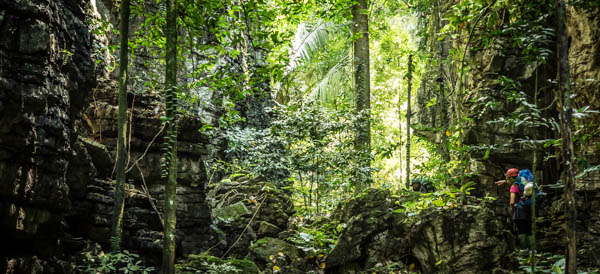Cave Fauna
Flora & Fungi
PROTECTED STATUS :
The
Senyum Cave Complex is surrounded by an ecosystem that supports the greatest diversity of living organisms on Earth--the rainforest. These rainforests are lowland dipterocarp forests, which are just one type of many, and alone can have up to 2000 different species of plants and trees. There is one species that can be found next to the trail on the north-eastern sector of the Senyum cave complex, that (literally) stands out from all the others. This tree, which
is actually not a dipterocarp, is known as 'tualang' and 'tapang'
(Koompassia excelsa) in Peninsular Malaysia and
Sarawak respectively. Tualang trees have been measured to just shy of 90 metres, making them one of the tallest trees in tropical rainforests. These magnificent heights require immense, and very unusual, root networks in order to support their gargantuan weight. Buttress roots do this by spreading horizontally across the forest floor. This not only stabilises the trees in strong winds, but also helps them to tap into the nutrient-rich upper soil layers. The sheer biodiversity of the rainforest means that there is fierce competition for nutrients, so any organic matter that is broken down is quickly leeched away from the soil, which is why the deeper levels of soil are nutrient-poor.
 Nails have been hammered in to the sides of this tualang tree (Koompassia excelsa) to facilitate the harvesting of honey; the massive buttress roots of an albino ara tree (Ficus sp.) in Jebak Puyuh
Nails have been hammered in to the sides of this tualang tree (Koompassia excelsa) to facilitate the harvesting of honey; the massive buttress roots of an albino ara tree (Ficus sp.) in Jebak Puyuh
Another unique characteristic of tualang trees are their smooth and slippery tree trunks. This, combined with their dizzying heights, makes it hard for sun bears
(Helarctos malayanus) to climb up to the upper canopies, which in turn makes tualang trees prime real estate for the huge honeycombs of giant honey bees
(Apis dorsata). The value of the honey turns out to be higher than the value of the trees' timber, which ultimately helps to protect the trees from loggers. In fact, logging tualang trees is a taboo amongst some indigenous peoples in
Sarawak!
 Horizontally-growing woody lianas
Horizontally-growing woody lianas
Leaf litter and organic matter on the forest floor are broken down by teams of natural recyclers, called detrivores, that obtain their nutrients from decomposing organic matter, called detritus. Detrivores include not only flies and their larvae (maggots), but also other arthropods like millipedes and beetles, molluscs like snails and slugs, and annelids like earthworms. Fungi are detrivores that start off the decomposition process by spreading out filamentous outgrowths called hyphae, which branch off and quickly invade the detritus. These hyphae, which collectively are called mycelium, are the main body of fungi;
mushrooms, on the other hand, are just the fruiting bodies that generally only appear when the fungi are ready to reproduce. Fungi are especially important for the decomposition of plants and trees as they produce the necessary enzymes that break down the tough structure of dead plants. Their initial penetration into the detritus also creates pathways that help water and other detritivores gain access, which in turn increases the overall rate of decomposition.
 Rotting organic matter is needed for fungi, like these yellow-stemmed micropores (Microporus xanthopus), to thrive
Rotting organic matter is needed for fungi, like these yellow-stemmed micropores (Microporus xanthopus), to thrive
There are many other rare and vulnerable plants that can be found around the area, such as the merawan jeruai tree
(Hopea sublanceolata) , the endemic
Senyumia minutiflora , and the
Impatiens ridleyi balsam. However, one of the most striking plants that you will undoubtedly come across is the giant elephant ear, one of which is
Colocasia gigantea, known locally as 'keladi gajah' ('gajah' meaning elephant in Malay--a reference to the leaves' resemblance to elephant ears). This plant is easily mistaken for
Alocasia macrorrhiza, as they both have massive leaves that are similar in shape. The easiest way to tell them apart is to look at the undersides of the leaves--Alocasias have long stems that continue on to the end of the leaves, which makes the leaves face upwards; Colocasias have stems that attach to the notch of the leaves, which means that the leaves can sometimes face downwards. In fact, some
academics think that the
Colocasia gigantea may have come from a natural crossing between
Alocasia macrorrhiza and
Colocasia esculenta!
Giant elephant ears are commonly seen along the sides of the trails around the caves, with their humongous leaves casting huge shadows. Their leaves are the largest unsplit leaves in the world, and can reach almost two metres in length. This large size translates into a massive area, which makes them vulnerable to being split by heavy rain; so the plant has evolved a simple defense mechanism: a light coating of wax that helps to reduce the surface contact of raindrops as they come into contact with the leaves, and makes the drops roll right off.
 The impressive leaves of the giant elephant ear (Colocasia gigantea). The stem here can be seen attached to the notch of the leaf
The impressive leaves of the giant elephant ear (Colocasia gigantea). The stem here can be seen attached to the notch of the leaf
 The iridescent tips of willdenow's spikemoss (Selaginella willdenowii)
The iridescent tips of willdenow's spikemoss (Selaginella willdenowii)










